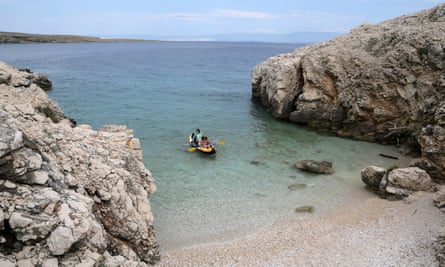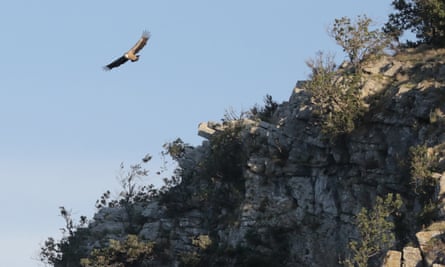If there is one thing to learn about Croatian islands, it’s that they are all different. Pag, for example, is all cheese and chalk, while Hvar is lavender and langoustines. But Cres is new to me and I want to know more about the joint-largest of the country’s 718 islands (only 47 of which are inhabited). On the map it’s a weird-looking, elongated creature, said by the ancient Greeks to be the body of Apsyrtus, murdered by Jason and his Argonauts. I’m on a hiking trail across the northern head of the island, the Tramuntana, and I’m on a Roman road. Not just the site of one, you understand, but the very cobbles laid down 2,000 years ago, although a local guide warned me that one short section was recently resurfaced – “by Napoleon”.
The way leads past olive trees that look like they were planted to shade travellers when the road was first built. I cross a modern asphalt road and the trail becomes an old country path: white stones smoothed by centuries of bare feet and donkey hooves. It is hot, but I am shaded by immense oak trees. Then I emerge on a meadow of short grass and enter a village.

Trees are laden with apples and sweet chestnuts ready to roast. The well is full of water. I glance inside a house and see wooden chests and beds. On a kitchen wall, next to an oven, someone has stencilled bunches of ripe grapes. The only thing missing is people: they all abandoned this village, and many others on Cres, after the second world war. What this island has in abundance, I’m realising, is ghosts.
Later that day I reach Beli, a hilltop village on the coast, and the best base for exploring Tramuntana. My partner Sophie and daughter Maddy (13) are waiting for me, as arranged, in the konoba, or taverna. Maddy is at a point in her life when she likes 25 hours of sleep a day and can only be roused by the whispering of certain key words: snorkelling, rock climbing and Coke. Sophie, however, is at a point in her life where those words put her to sleep. For her, “beach and book” usually hits the spot, though the addition of “white wine” always helps. We are on a family road trip through Croatia.

At the Eco-Centre down the lane I meet Tomislav, an unusual young Croatian in that he has moved away from the city of Rijeka and reinhabited his grandfather’s remote village, Ivanje, in the centre of the Tramuntana. “Some of those old people who emigrated come back to look,” he says. “They’re very nostalgic. They never found peace in the city.”
The language they spoke, however, the Tramuntana dialect, will never come back: the last known speaker died in 2015. Cres wine and cheese are more or less extinct, too. Now Tomislav is working to try to save another disappearing part of the old scene: the griffon vulture.

In former times, people kept sheep, and the vultures fed on any carcasses. But now the shepherds and their flocks are rare and the vultures – once common all across Europe, even in Britain – are struggling. “They will fly to the Alps to find food,” says Tomislav. “And they are easily disturbed by tourist boats.”
In a large enclosure, the project is rehabilitating three young specimens that were rescued from the sea after falling from their nests. Since there are only around 50 pairs left on Cres, they are a vital part of the rescue plan. They look a bit shabby and clumsy in their pen. Tomislav assures us their wild relatives are more impressive and that viewing is possible. “Take the cliff path from the town beach and keep going as far as you can.” Cres griffons are highly unusual in their nesting on sea cliffs.

I whisper “swimming” in Maddy’s ear; “beach and book” in Sophie’s.
When I say Cres is relatively uninhabited, I should also point out that there are two seasons in Croatia: the quiet time and August. During the latter, any beach near a road is certain to be popular. The coast near Beli is largely taken over by Italians.
There are some simple country cafes, a kayak hire agency, a zipwire and a dive centre. But after picking our way through the sunning flesh, we find a gorgeous narrow path along the cliff where the wild sage grows. There is a second beach with about six people on it, then a third with two. Any further progress is blocked by a sign announcing that the next cliff is a griffon nesting site. We can’t see any sign of them, however.

Maddy and I swim. Sophie reads. I cannot think of anywhere that has seas clearer than in Croatia. I could stare in astonishment at those colours all day long: glassy grass-green, malachite, turquoise, or Homeric wine dark.
Hiring a boat is highly recommended. Best spots for that are Valun and Martinšćica on the west side of the island. Ask to be taken to the Blue Grotto under the village of Lubenice, but try to get there early because every motor boat heads there for lunch. The village on the cliff above makes a great sunset spot.

With a canoe or kayak, places like Koromaćno near Belej are a good bet: a short paddle will soon reveal an empty beach. Watch out for the wind, though: the bura and the jugo are just two of the vicious local furies sent to torture mariners. If in doubt contact the excellent pansion in Beli which organises coastal expeditions and has copies of a useful hiking map.

As Maddy and I get out of the water, the sun is sinking fast. I’ve decided I will have to come back at dawn tomorrow to catch sight of a griffon vulture. Then a shadow crosses the sky: a massive bird that sweeps over us imperiously, followed by another and another. They are so close we can see their white heads turning to check us out, but then they soar higher and higher before folding their wings into powerful swoops and disappearing over the mountain. The humans may have become ghosts, but on Cres the vultures remain the overlords.
Discovering Croatia: the spirit world
There is a baffling array of spirits awaiting discovery in Croatia, from the more well-known slivovitz (plum brandy) to the esoteric biska, a type of grappa concocted from mistletoe and popular in Istria. A favourite liqueur is smokovača (made from dried figs) which is sweeter than the often astringent travarica (various herbs), which is served as an aperitif. Then there is orahovac (walnuts), medica (honey), kruškovac (pears) and rogač (carob), which someone memorably described to me as having a bouquet like “cocoa and arse”.

Comments (…)
Sign in or create your Guardian account to join the discussion